This gluten-free pumpernickel bread is perfect for toasting and spreading with cream cheese or butter, or for making sandwiches, or dipping in soups. Made with teff flour for fiber and texture, this beautifully dark pumpernickel bread recipe is going to be a favorite, so make sure to keep it handy! Bake a loaf or two and freeze to enjoy homemade bread anytime. Totally dairy-free too, but no one would care!

Want to save this recipe?
Enter your email & I’ll send it to your inbox. Plus, get great new recipes from me every week!
Jump to:
- I Love a Loaf of Homemade Bread
- What is Pumpernickel Bread?
- Is Pumpernickel Gluten-Free?
- A Gluten-Free Version of Pumpernickel
- Why This Recipe Works:
- Ingredients You’ll Need:
- Recipe Notes + Substitutions
- How to Make Gluten-Free Pumpernickel Bread (Step by Step)
- Dish by Dish Tips/Tricks:
- Recipe FAQs:
- Other Gluten-Free Yeast Breads You’ll Love:
- Bake a Loaf of Bread!
- Gluten-Free Pumpernickel Bread (Dairy-Free)
I Love a Loaf of Homemade Bread
Nothing makes my day better than a freshly baked loaf of bread, and having the aroma of fresh bread wafting around my kitchen makes any situation feel better.
If you’ve followed along this blog for a while, you might know that I love homemade bread, and some of our absolute favorite gluten free bread recipes include:
What is Pumpernickel Bread?
Traditionally, pumpernickel bread is a dense and slightly sweet bread that is a dark brown in color. While it was originally peasant food, pumpernickel has become more popular.
Originating in Germany, the European version is usually denser and made up of a combination of sourdough, rye flour and rye berries (also known as rye bread).
The North American version usually also includes wheat flour, as well as colorings to create the desired dark brown appearance and uses yeast instead of sourdough.
Is Pumpernickel Gluten-Free?
Is there gluten in pumpernickel bread? Here’s the deal. The traditional version of pumpernickel is made of rye and sometimes wheat, which both include gluten. So the normal pumpernickel you find in the supermarkets or delicatessens will usually not be suitable for Celiacs.
A Gluten-Free Version of Pumpernickel
I’ve long wanted to develop a gluten-free and dairy-free version of pumpernickel, and finally got around to doing it.
In my version, I really enjoy the sweetness of the bread, the richness of taste that it has from the molasses and cocoa powder, and the fact that this recipe results in a slightly less more fluffy texture (compared to the denser and drier texture of its traditional counterpart).
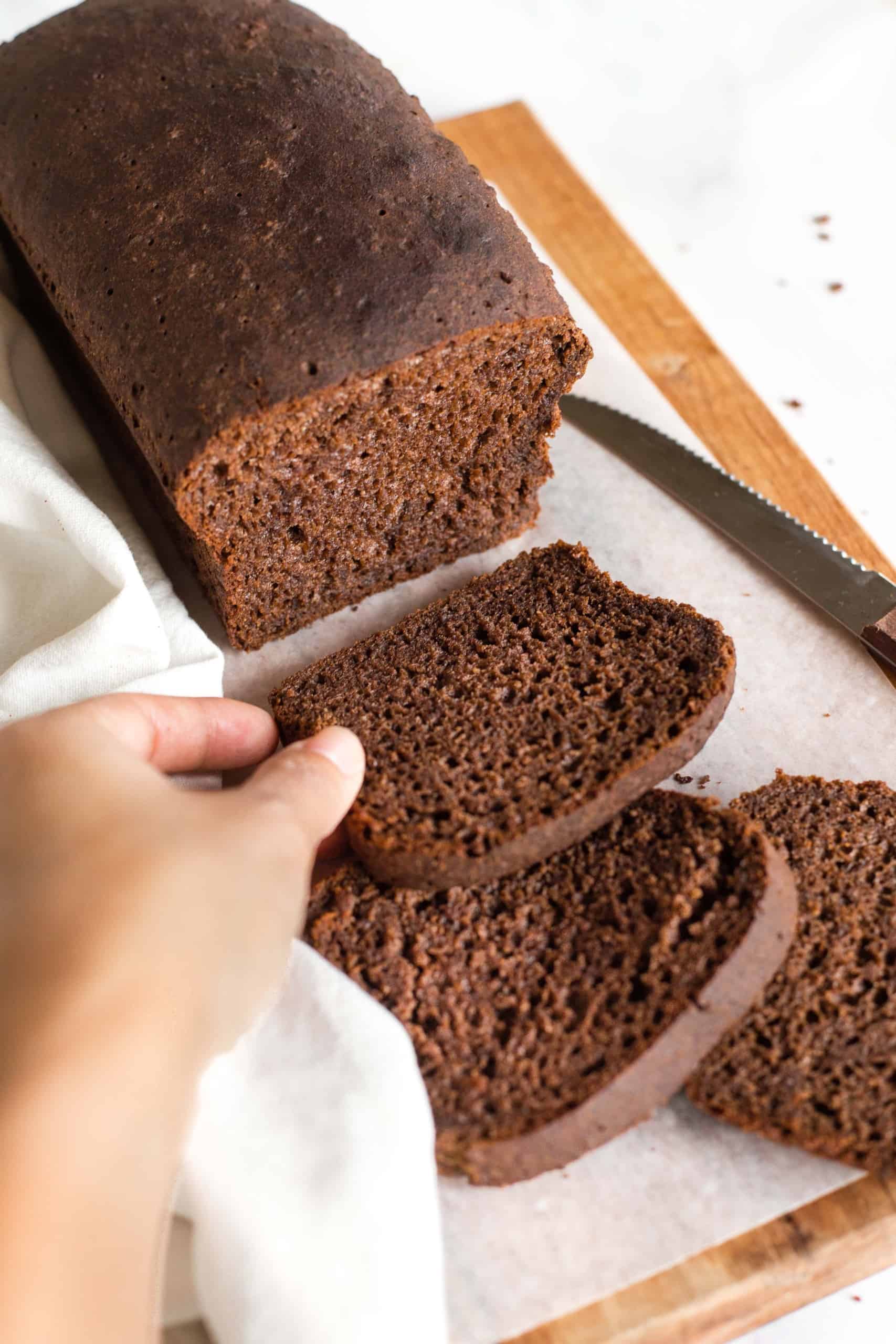
Why This Recipe Works:
- Simple Ingredients: While you may not have all the ingredients on hand, the ingredients in this recipe are easily accessible in the local grocery market.
- Easy to Make: This pumpernickel recipe comes together so easily. It’s all about mixing the wet ingredients with the dry ingredients to get the dough, and then letting the dough double in size before baking! Plus, there’s no kneading required!
- Perfect Texture: Unlike traditional pumpernickel bread that tends to be extremely dry and dense, my version is a little airier and fluffier. It’s delicious toasted and spread with jam, or eaten as a sandwich bread, or dipped in soups!
- Totally Gluten-Free and Dairy-Free: Best of all, this homemade pumpernickel recipe is 100% gluten-free and dairy-free, which means that even those with Celiac disease or lactose or gluten intolerances can still enjoy it! Replacing rye flour with teff flour (which is naturally gluten-free), and using a gluten-free flour blend in place of wheat flour, this recipe is utterly delicious.
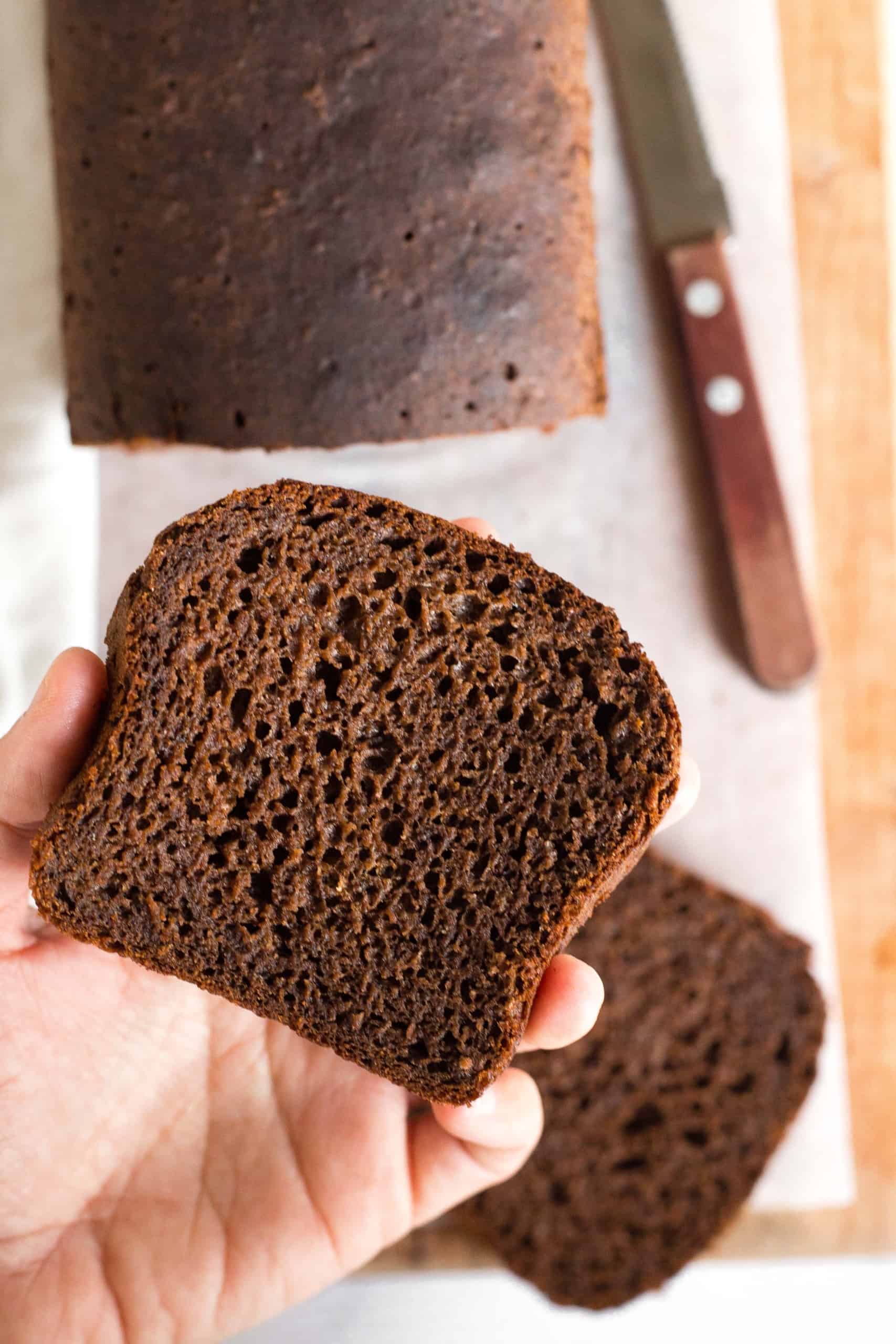
Ingredients You’ll Need:
Here’s a visual overview of the ingredients required for this gluten-free pumpernickel bread recipe.
(For exact measurements and quantities, please scroll down to the recipe card at the bottom of this post.)
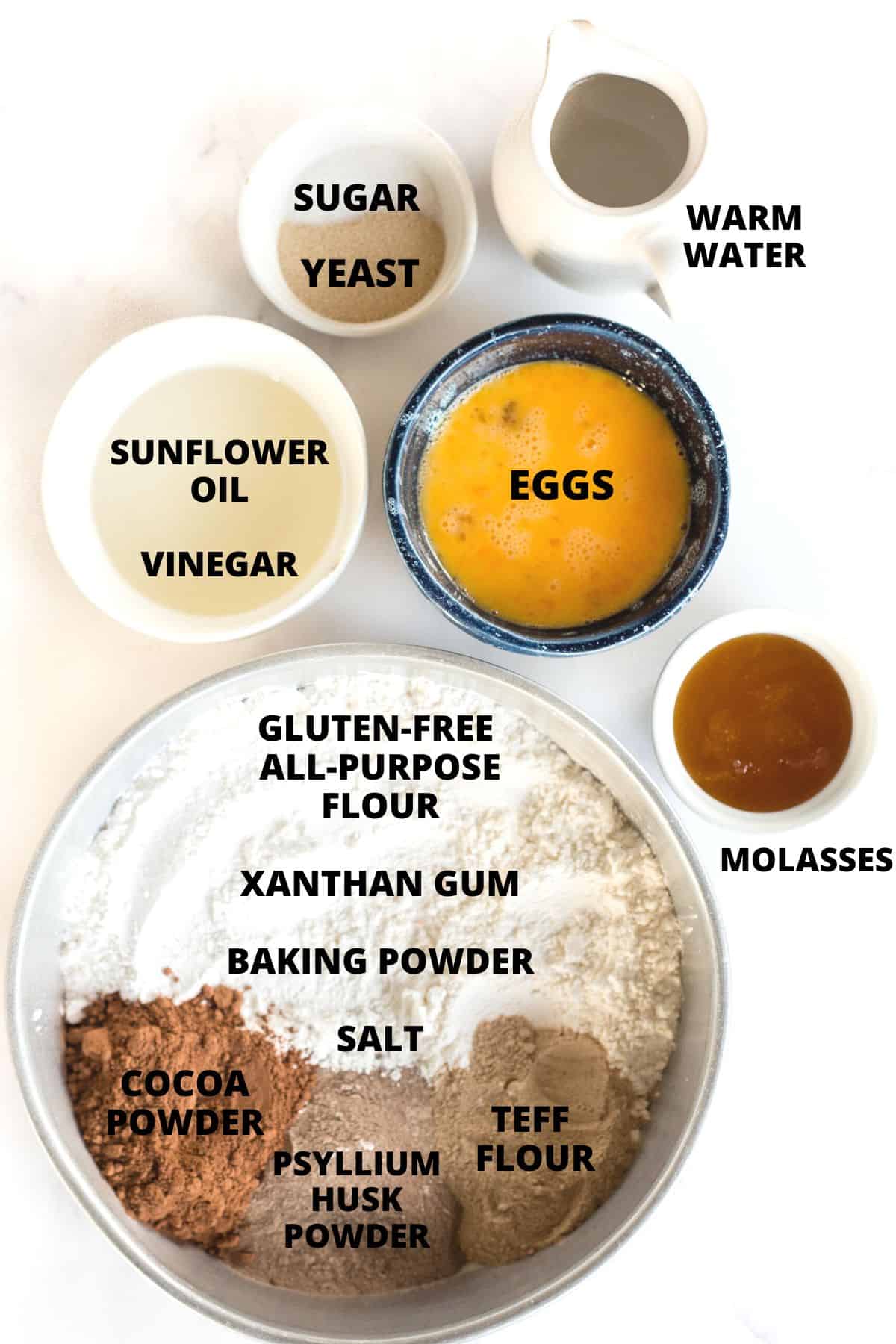
Recipe Notes + Substitutions
- Gluten-Free All-Purpose Flour: I recommend using a good-quality gluten-free all-purpose flour blend that includes lighter flours and starches (such as rice flour, tapioca starch, corn starch or potato starch) to ensure a lighter final texture. I do NOT recommend using a gluten-free flour blend that includes heavier flours (such as garbanzo bean flour) as that will result in a very dense final texture.
- Xanthan Gum: Xanthan gum is the replacement for gluten in gluten-free flours, so I recommend adding it if your gluten-free flour blend does not already include it.
- Teff Flour: I used teff flour to give the pumpernickel dough its characteristically darker color and high-fiber texture. However, you may also use a mix of wholegrain gluten-free flours such as buckwheat flour, millet flour, sorghum flour and brown rice flour if you prefer.
- Psyllium Husk Powder: Psyllium husk powder helps to better bind the ingredients together and gives the dough the elasticity required when it is rising and to maintain its dome shape once risen.
- Cocoa Powder: I’ve added unsweetened cocoa powder give the pumpernickel loaf its traditionally deep brown color. You may also use equal amounts of unsweetened cacao powder if you prefer.
- Baking Powder: This pumpernickel bread recipe uses both baking powder and yeast to give the dough extra rising power. If you are Celiac or gluten-intolerant, make sure to use certified gluten-free baking powder.
- Instant Yeast: I like using instant yeast because there is no pre-activation time required, and you can mix the yeast directly with the dry ingredients. If you only have active dry yeast, simply activate it beforehand with the warm water and sugar before adding it to the other ingredients.
- Sugar: Sugar is needed as “food” for the yeast to feed on in order to produce the gases required for making the dough rise. I used while sugar, but you can also use light brown sugar or dark brown sugar if you prefer.
- Molasses: In addition to the cocoa powder, the molasses also adds to the rich brown color of the loaf once fully baked. You can use either blackstrap molasses, or light or dark molasses. You may also use honey, maple syrup, or agave nectar if you prefer.
- Sunflower Oil: I like using sunflower oil because I always have a bottle of it on hand. You may use another type of vegetable oil such as olive oil, melted coconut oil, or avocado oil if you prefer. Alternatively, if you are not lactose-intolerant, feel free to use melted butter or ghee if you like.
- Vinegar: Vinegar creates an acidic environment that reacts with the alkaline nature of baking powder to create the gases which cause the air bubbles in bread dough to form. You may also use equal amounts of apple cider vinegar if you prefer.
- Warm Water: Make sure that the water used is between 105F to 115F, because the warmth is needed to activate the yeast, but if the water is too hot, it will kill the yeast instead. Alternatively, if you prefer, you can also use warm milk instead (such as almond milk, cashew milk, rice milk, or oat milk).
- Eggs: Eggs help to bind the ingredients together, as well to give the bread dough rise. You may also use 4 egg whites instead of 2 whole eggs if you prefer. I have not tried making this recipe without eggs, but if you are allergic to eggs, you can try substituting the eggs with acquafaba or an egg-replacer. (If you do make this recipe without eggs, please let me know how it goes in the comments below. I’d love to know!)
How to Make Gluten-Free Pumpernickel Bread (Step by Step)
1. Preheat and Grease
Grease an 8″ x 4″ metal loaf pan and then preheat the oven to 350F. Arrange the oven rack to the middle position.
(Alternatively, you may also line the loaf pan with parchment paper to help you more easily remove the loaf once baked.)
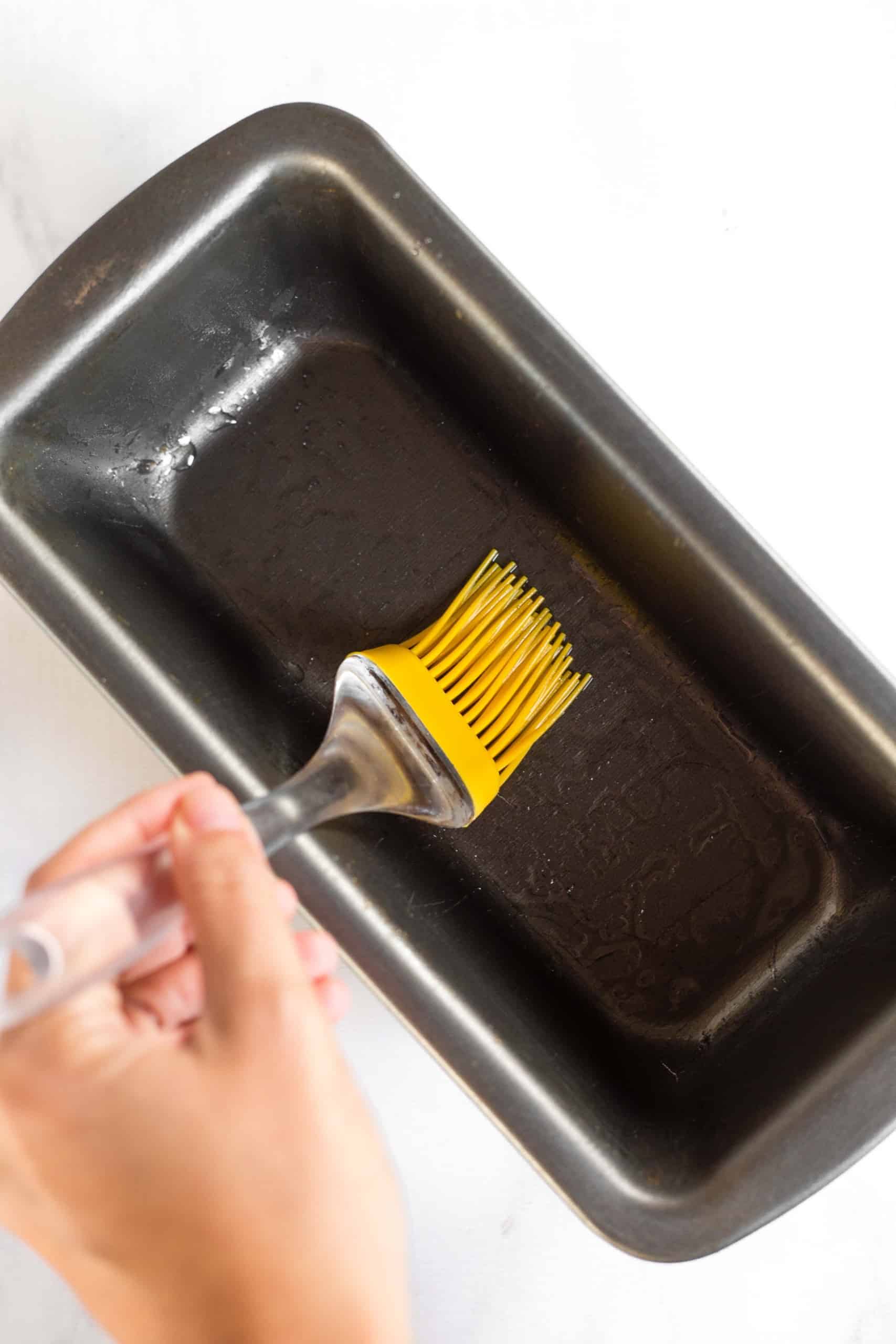
2. Combine Dry Ingredients
In a large mixing bowl, combine the gluten-free all-purpose flour, xanthan gum (if using), teff flour, psyllium husk powder, unsweetened cocoa powder, baking powder, instant yeast, sugar and salt. Whisk well to combine.
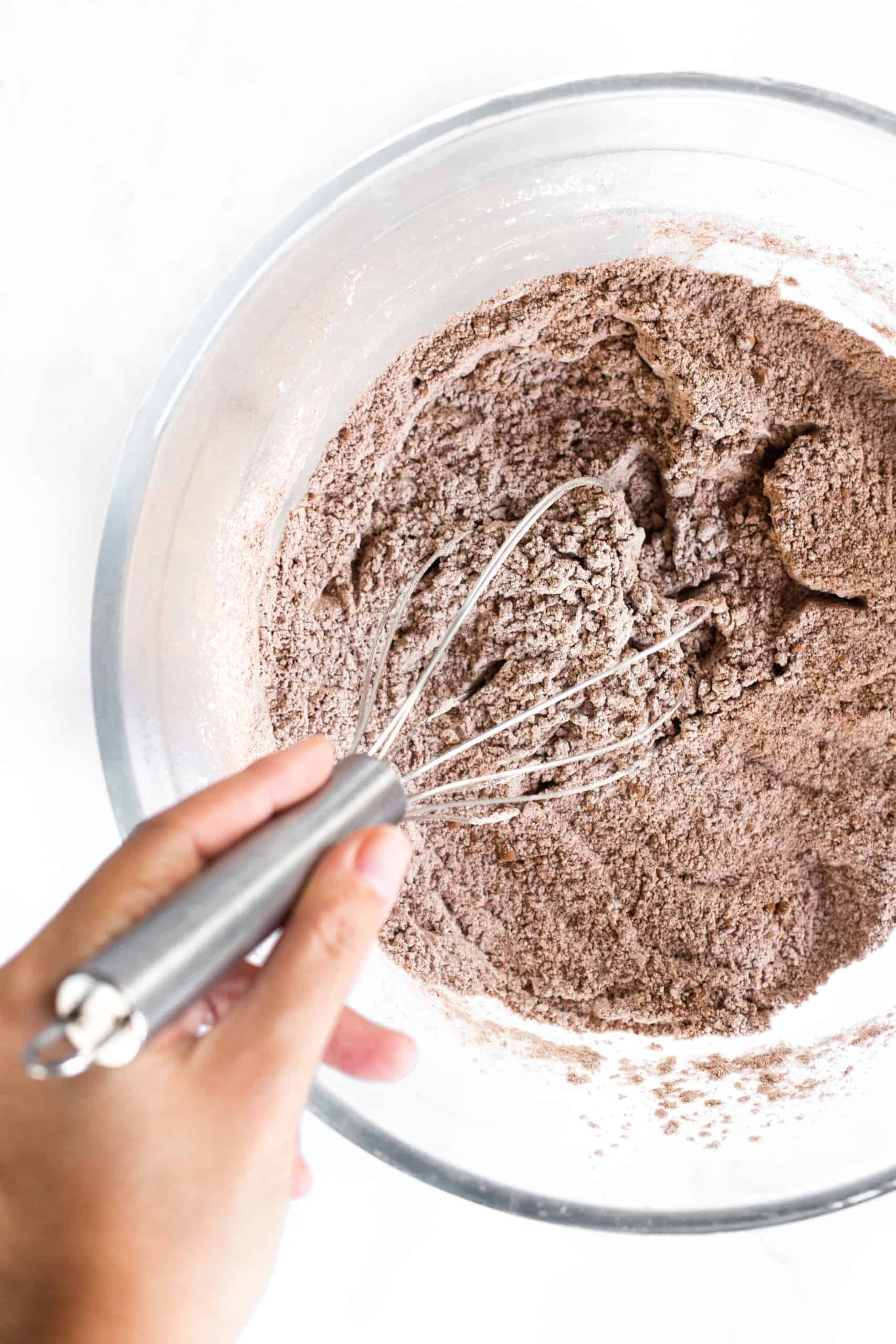
3. Add Wet Ingredients
Add the molasses, sunflower oil, vinegar, warm water, and beaten eggs to the large bowl with the dry ingredients. Mix well until you get a wet, sticky dough that resembles brown cake batter.

4. Transfer to Loaf Pan
Transfer the pumpernickel bread dough to the previously-greased bread pan and smooth out the top with a wet rubber spatula.

5. Let Rise
Let the dough rise in a warm place away from any drafts for at least 30 minutes until it has doubled in size.
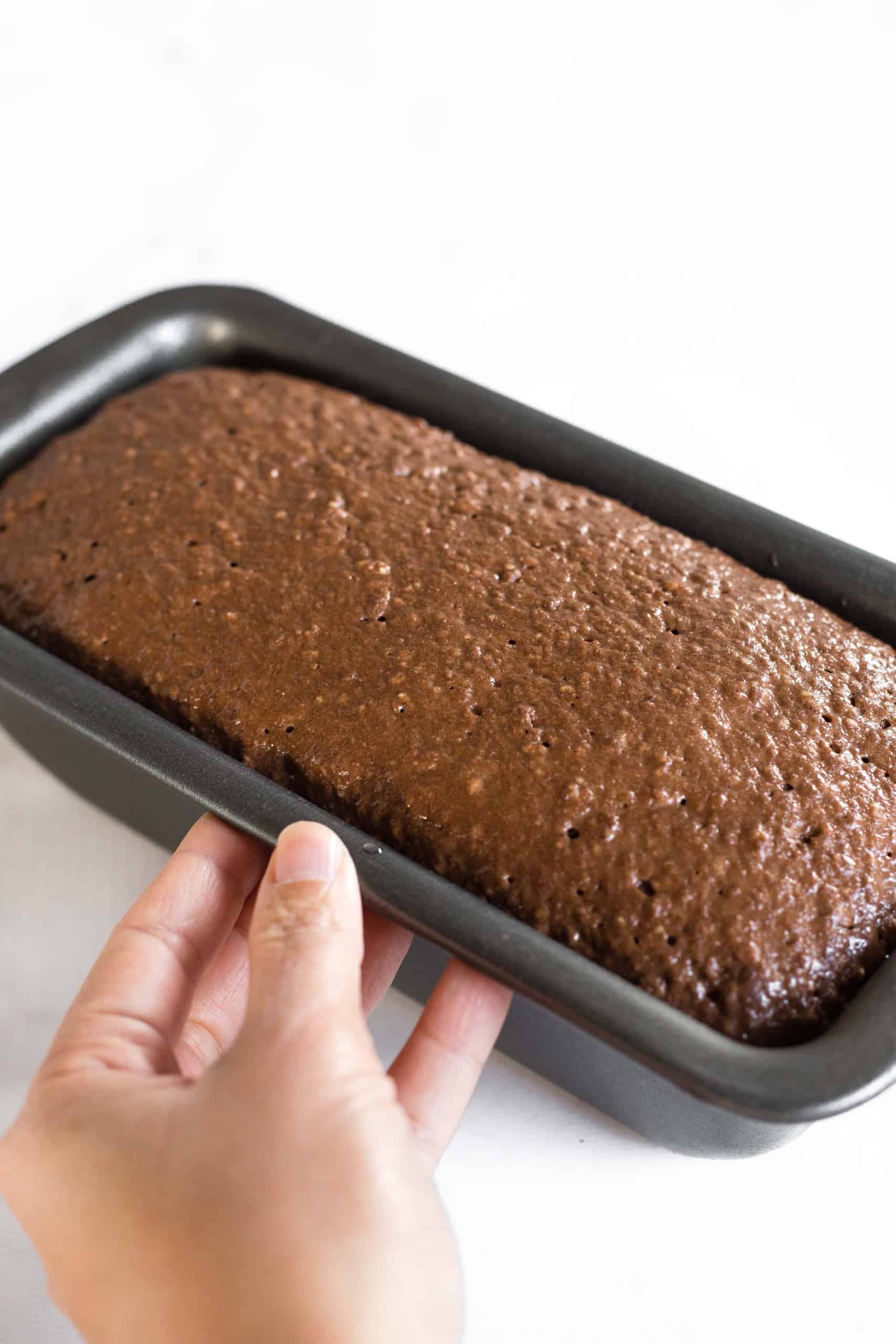
6. Bake Until Ready
Bake the dough for 50 to 60 minutes until the gluten-free pumpernickel bread is dark brown on top and sounds hollow when tapped.

7. Cool Fully
Allow the gluten-free pumpernickel bread to cool for at least 10 minutes in the loaf pan before removing it and letting it cool completely at room temperature on a cooling rack.
8. Slice and Enjoy
Once the loaf has fully cooled, slice and enjoy!
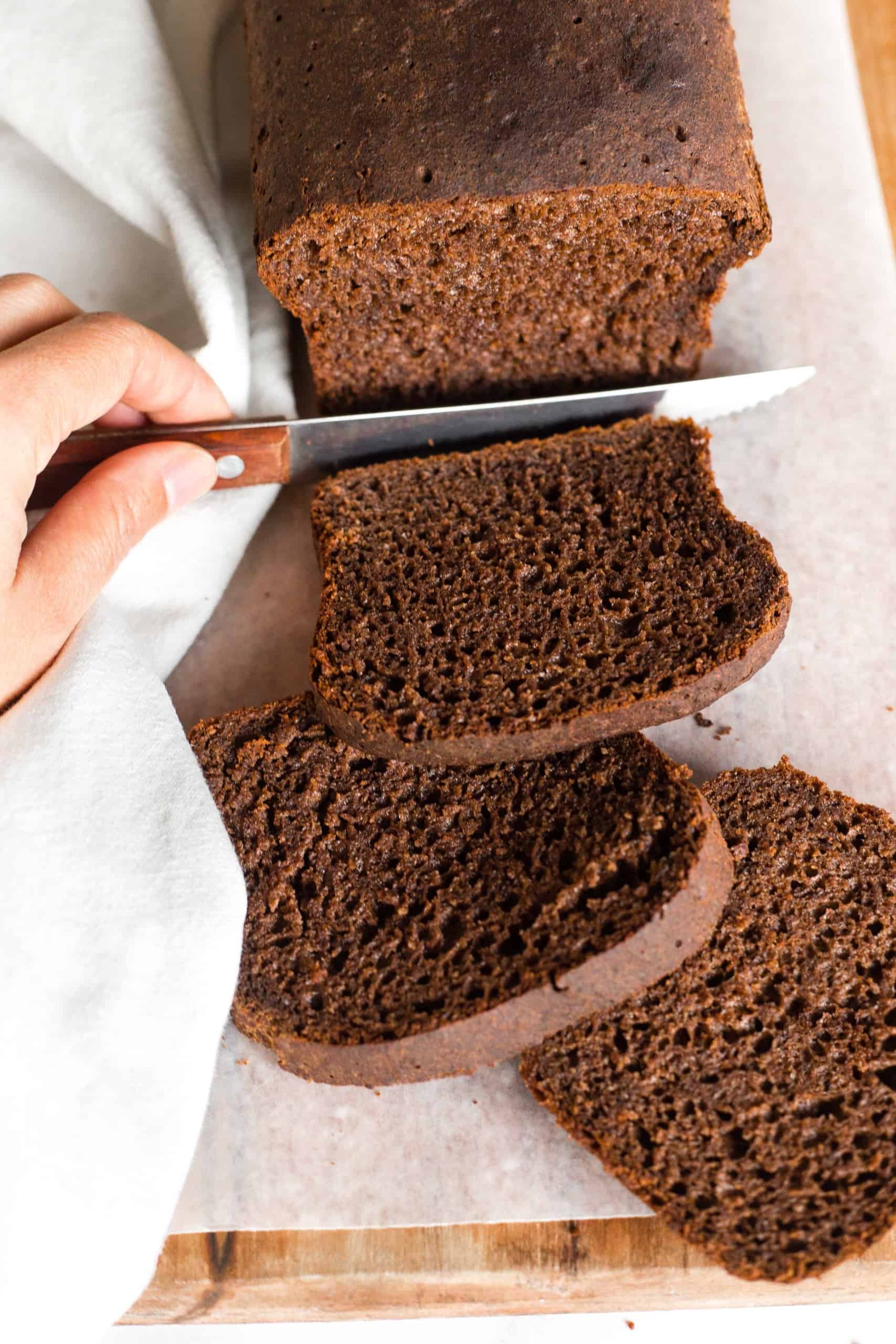
Dish by Dish Tips/Tricks:
- Use a Metal Pan: I recommend using a metal loaf pan because metal conducts heat more evenly, which ensure that the gluten-free pumpernickel bread loaf is thoroughly cooked on all sides.
- Pan Size Determines Loaf Height: I used an 8″ x 4″ loaf pan, and the loaf comes out perfect with this pan size. If you use a large pan, bear in mind that the loaf will probably come out wider and flatter in height.
- Optional Toppings: Feel free to top this easy pumpernickel bread with a mix of seeds (such as pumpkin seeds, sunflower seeds, sesame seeds, chia seeds and flax seeds). You may also mix a sprinkle of caraway seeds into the bread dough for extra flavor.

Recipe FAQs:
The traditional version of pumpernickel is made of rye and sometimes wheat, which both include gluten. So the normal pumpernickel you find in the supermarkets or delicatessens will usually not be suitable for Celiacs or those on a gluten-free diet.
To store, place the cooled pumpernickel loaf in an airtight container or wrap it in various layers of plastic wrap, then store in the refrigerator for up to 5 days.
Yes you may! To freeze, wrap the cooled gluten-free pumpernickel in various layers of plastic wrap and freeze for up to 2 months. Let loaf thaw completely overnight in the refrigerator before slicing.
Because this gluten-free pumpernickel bread tends to be slightly on the sweet side, it pairs really well with cream cheese, egg salad, sliced onions, cucumbers and even mustard. It is also great with soups such as this gluten-free tomato soup, our creamy pumpkin soup, and carrot turmeric soup.
I don’t own a bread maker, so I’ve not personally made it in a bread machine. However, I believe you can select the gluten-free setting on your bread machine, then follow the manufacturer’s instructions and it should work.

Bake a Loaf of Bread!
P.S. If you try this recipe, I’d love for you to leave a star rating below, and/or a review in the comment section further down the page. I always appreciate your feedback. Be sure to check out my entire Recipe Index for all the recipes on the blog. You can also follow me on Pinterest, Facebook or Instagram! Sign up for my Email List to get fresh recipes in your inbox each week!
Print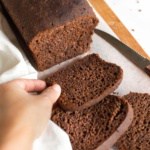
Gluten-Free Pumpernickel Bread (Dairy-Free)
- Total Time: 1 hour 40 minutes
- Yield: 12 slices 1x
- Diet: Gluten Free
Description
This gluten-free pumpernickel bread is perfect for toasting and spreading with cream cheese or butter, or for making sandwiches, or dipping in soups. Made with teff flour for fiber and texture, this beautifully dark pumpernickel bread recipe is going to be a favorite, so make sure to keep it handy! Bake a loaf or two and freeze to enjoy homemade bread anytime. Totally dairy-free too, but no one would care!
Ingredients
- 1 1/2 cups gluten-free all-purpose flour
- 3/4 teaspoon xanthan gum (omit if your flour blend already includes it)
- 3/4 cups teff flour
- 2 tablespoons psyllium husk powder
- 1/4 cup unsweetened cocoa powder
- 1 teaspoon baking powder
- 2 1/4 teaspoons instant yeast
- 1 tablespoon sugar
- 1 teaspoon salt
- 1/4 cup molasses
- 1/3 cup sunflower oil
- 1 teaspoon vinegar
- 1 1/3 cups warm water (between 105F to 115F)
- 2 large eggs, beaten
Instructions
- Preheat and Grease: Grease an 8″ x 4″ metal loaf pan and then preheat the oven to 350F. Arrange the oven rack to the middle position.
- Combine Dry Ingredients: In a large mixing bowl, combine the gluten-free all-purpose flour, xanthan gum (if using), teff flour, psyllium husk powder, unsweetened cocoa powder, baking powder, instant yeast, sugar and salt. Whisk well to combine.
- Add Wet Ingredients: Add the molasses, sunflower oil, vinegar, warm water, and beaten eggs to the large bowl with the dry ingredients. Mix well until you get a wet, sticky dough that resembles brown cake batter.
- Transfer to Loaf Pan: Transfer the pumpernickel bread dough to the previously-greased loaf pan and smooth out the top with a wet spatula.
- Let Rise: Let the dough rise in a warm, draft-free place for at least 30 minutes until it has doubled in size.
- Bake Until Ready: Bake the dough for 50 to 60 minutes until loaf is dark brown on top and sounds hollow when tapped.
- Cool Fully: Allow the gluten-free pumpernickel loaf to cool for at least 10 minutes in the loaf pan before removing it and letting it cool completely at room temperature on a wire rack.
- Slice and Enjoy: Once the loaf has fully cooled, slice and enjoy!
Notes
Gluten-Free All-Purpose Flour: I recommend using a good-quality gluten-free all-purpose flour blend that includes lighter flours and starches (such as rice flour, tapioca starch, corn starch or potato starch) to ensure a lighter final texture. I do NOT recommend using a gluten-free flour blend that includes heavier flours (such as garbanzo bean flour) as that will result in a very dense final texture.
Xanthan Gum: Xanthan gum is the replacement for gluten in gluten-free flours, so I recommend adding it if your gluten-free flour blend does not already include it.
Teff Flour: I used teff flour to give the pumpernickel dough its characteristically darker color and high-fiber texture. However, you may also use a mix of wholegrain gluten-free flours such as buckwheat flour, millet flour, sorghum flour and brown rice flour if you prefer.
Psyllium Husk Powder: Psyllium husk powder helps to better bind the ingredients together and gives the dough the elasticity required when it is rising and to maintain its dome shape once risen.
Cocoa Powder: I’ve added unsweetened cocoa powder give the pumpernickel loaf its traditionally darker color. You may also use equal amounts of unsweetened cacao powder if you prefer.
Baking Powder: This bread recipe using both baking powder and yeast to give the dough extra rising power. If you are Celiac or gluten-intolerant, make sure to use certified gluten-free baking powder.
Instant Yeast: I like using instant yeast because there is no pre-activation time required, and you can mix the yeast directly with the dry ingredients. If you only have active dry yeast, simply activate it beforehand with the warm water and sugar before adding it to the other ingredients.
Sugar: Sugar is needed as “food” for the yeast to feed on in order to produce the gases required for making the dough rise. I used while sugar, but you can also use light brown sugar or dark brown sugar if you prefer.
Molasses: In addition to the cocoa powder, the molasses also adds to the rich brown color of the loaf once fully baked. You may also use honey, maple syrup, or agave nectar if you prefer.
Sunflower Oil: I like using sunflower oil because I always have a bottle of it on hand. You may use other vegetable oils such as olive oil, melted coconut oil, or avocado oil if you prefer. Alternatively, if you are not lactose-intolerant, feel free to use melted butter or ghee if you like.
Vinegar: Vinegar creates an acidic environment that reacts with the alkaline nature of baking powder to create the gases which cause the air bubbles in bread dough to form. You may also use equal amounts of apple cider vinegar if you prefer.
Warm Water: Make sure that the water used is between 105F to 115F, because the warmth is needed to activate the yeast, but if the water is too hot, it will kill the yeast instead. Alternatively, if you prefer, you can also use warm dairy-free milk (such as almond milk, cashew milk, rice milk, or oat milk).
Eggs: Eggs help to bind the ingredients together, as well to give the bread dough rise. I have not tried making this recipe without eggs, but if you are allergic to eggs, you can try substituting the eggs with acquafaba or an egg-replacer. (If you do make this recipe without eggs, please let me know how it goes in the comments below. I’d love to know!)
Storing/Freezing: To store, place the cooled pumpernickel loaf in an airtight container or wrap it in various layers of plastic wrap, then store in the refrigerator for up to 5 days. To freeze, wrap the cooled gluten-free pumpernickel in various layers of plastic wrap and freeze for up to 2 months. Let loaf thaw completely overnight in the refrigerator before slicing.
- Prep Time: 10 mins
- Rising Time: 30 mins
- Cook Time: 60 mins
- Category: Bread
- Method: Baking
- Cuisine: Western

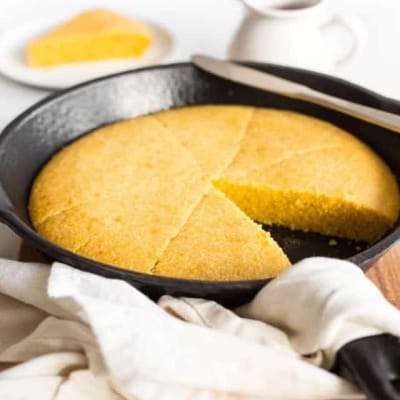
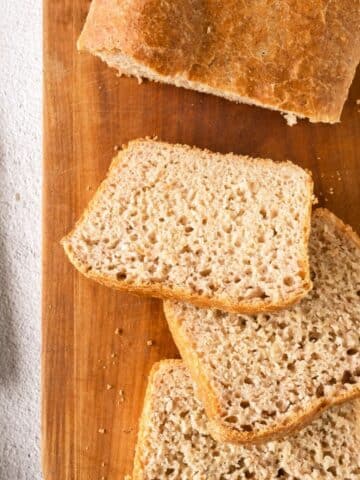
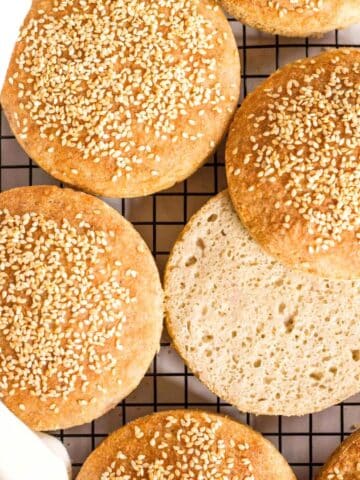
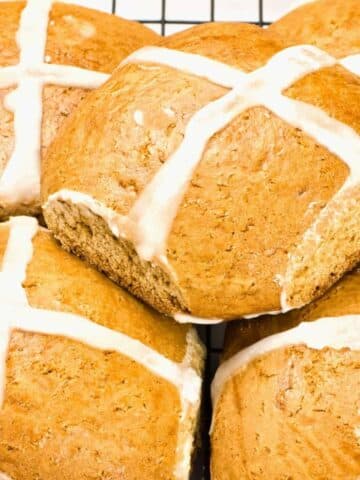
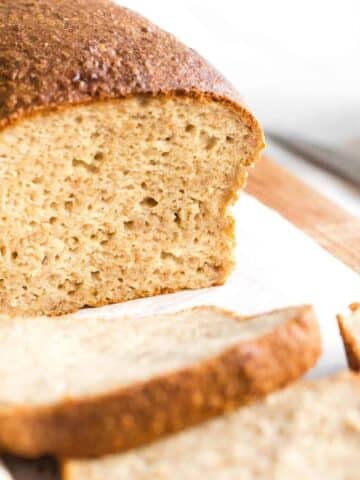
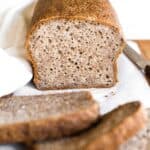
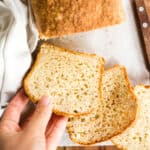
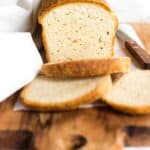
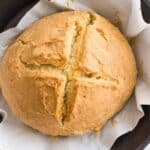

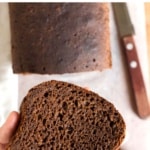
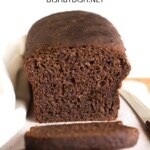
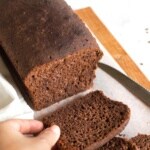
This was outstanding! I used 2 T flaxseed meal with 6 T water as the egg replacer. I also added 1 cup of raisins and ! T caraway seeds. I replaced teff flour with buckwheat flour. Also used extra light olive oil instead of sunflower oil. For the sugar, I used dark brown. Best pumpernickel recipe ever! Thanks!
Hi Joyce, so happy to hear you enjoyed this pumpernickel! Loved the addition of raisins and caraway seeds. Thanks for sharing how it went. Happy holidays to you, and hope to see you around the blog again sometime soon!
xx,
Felicia
Felicia is it possible to leave out psyllium, it doesn’t agree with me?
Hi Linda, if you can’t take psyllium, you can leave it out. Just bear in mind that the bread might not dome as nicely without the psyllium husk powder (which gives it the structure and the binding powder).
Hello Felicia,
This is the first time I have heard of this pumpernickel bread and your recipe seemed interesting in creating a more airy and fluffy version compared to the original German traditional version.
I must say the the name itself “pumpernickel” attracted me alot and I would like to try out your recipe to enjoy this pumpernickel bread when I got all my ingredients together.
Thumbs up for your creative variation to make this bread recipe gluten -free, less dense, airy and fluffy – a texture which may be more palatible to us in Singapore.
Sending you lots of love,
Mum
Hi mummy, let me know what you think if you eventually do try this pumpernickel recipe.
To make a round loaf, would a glass pie plate or cast iron frying pan work? Will it turn out ok?
Hi Mel! I think you can try with a glass pie plate, or if you have a round cake pan, that could work too.